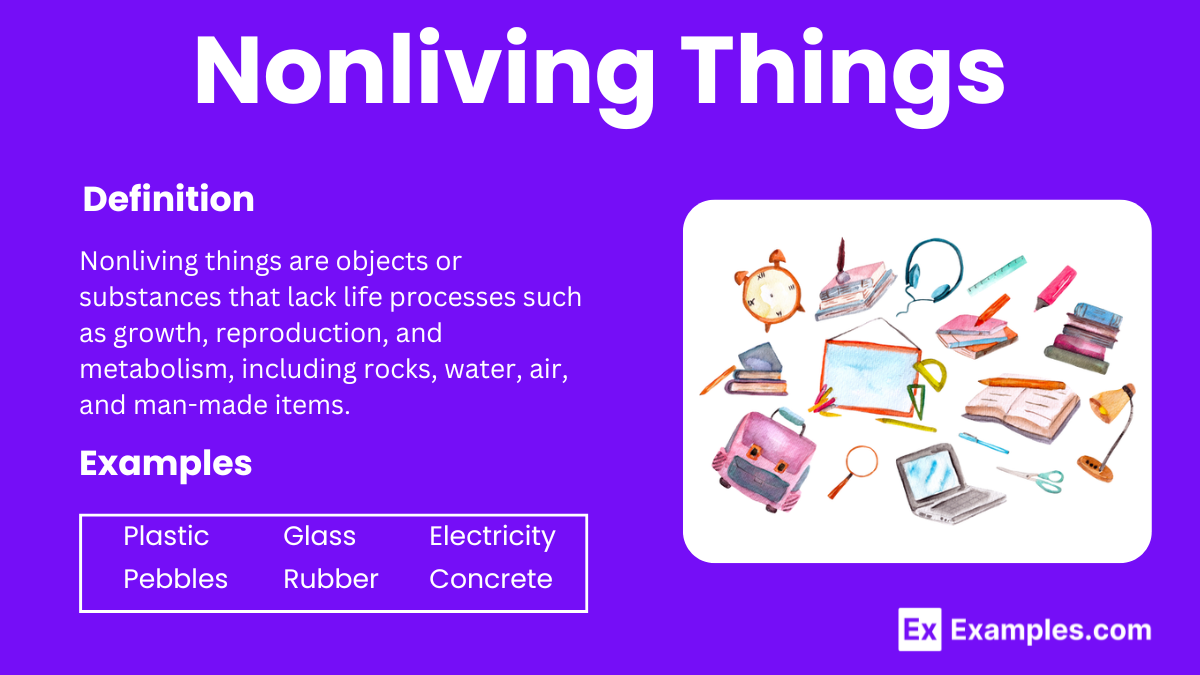What is the primary characteristic that distinguishes nonliving things from living things?
Ability to grow
Ability to reproduce
Ability to carry out metabolism
Lack of cellular structure


Nonliving things, also known as abiotic factors, play a crucial role in our environment. Unlike living organisms, these elements do not grow, reproduce, or undergo metabolism. Examples include water, air, rocks, and temperature. Understanding abiotic factors is essential for grasping ecosystem dynamics. An environmental brochure often highlights these elements to educate the public on their importance in maintaining ecological balance and supporting life processes.
Non-living things are elements that do not possess life. They lack biological processes like growth, reproduction, and metabolism. Examples include water, air, rocks, and temperature. These factors are essential in shaping ecosystems and supporting living organisms.

| Aspect | Living Things | Non-Living Things |
|---|---|---|
| Growth | Grow by internal processes (cell division) | Do not grow; remain the same size |
| Reproduction | Reproduce to produce offspring | Do not reproduce |
| Metabolism | Have metabolic processes (respiration, digestion) | No metabolism; no energy conversion |
| Response to Stimuli | Respond to environmental stimuli (light, heat) | Do not respond to stimuli |
| Adaptation/Evolution | Adapt and evolve over generations | Do not adapt or evolve |
| Composition | Made of cells; complex structure | Made of molecules; simpler structure |
No, non-living things do not grow.
No, non-living things do not require energy.
No, non-living things cannot reproduce.
No, non-living things do not evolve.
No, non-living things cannot move independently.
No, non-living things do not respond to stimuli.
No, non-living things are not made of cells.
Examples include water, rocks, air, and plastic.
They provide essential resources and support habitats.
No, non-living things do not undergo metabolism.
Text prompt
Add Tone
10 Examples of Public speaking
20 Examples of Gas lighting
What is the primary characteristic that distinguishes nonliving things from living things?
Ability to grow
Ability to reproduce
Ability to carry out metabolism
Lack of cellular structure
Which of the following is considered a nonliving thing?
A bacterium
A plant
A rock
A fish
Why are viruses considered nonliving?
They cannot reproduce on their own
They have a cellular structure
They can perform metabolism
They are made of organic materials
Which of the following properties is not typical of nonliving things?
Reactivity to stimuli
Ability to metabolize nutrients
Ability to undergo physical
Ability to maintain homeostasis
What is a key feature that both living and nonliving things share?
Ability to reproduce
Ability to grow
Ability to respond to environmental changes
Ability to carry out photosynt
Which of the following is an example of a nonliving thing that can be affected by biological processes?
An apple
A tree
A piece of wood
A cell
How do nonliving things differ from living things in terms of energy use?
Nonliving things use energy for growth
Nonliving things do not use energy for metabolic processes
Nonliving things can store and use energy
Nonliving things convert energy into chemical forms
Which characteristic is common among all nonliving things?
Ability to reproduce
Ability to adapt to their environment
Ability to maintain homeostasis
Lack of internal organization and structure
Which of the following can be classified as a nonliving component of an ecosystem?
A mushroom
A cloud
An earthworm
A fish
Which statement is true about nonliving things in terms of chemical composition?
Nonliving things do not have chemical compounds
Nonliving things have complex organic compounds
Nonliving things are composed of inorganic compounds
Nonliving things have the same chemical composition as living things
Before you leave, take our quick quiz to enhance your learning!

